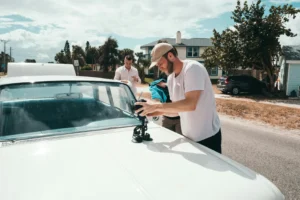What is BTS in Filmmaking?

Benevolent behind the camera’s magic
Watching a movie or a TV program reveals the polished final result: the riveting moments, perfect acting, breathtaking images, and smooth narrative. But have you ever considered what goes on behind the scenes to realize that cinematic masterpiece?
Within the film industry, BTS is “Behind The Scenes.” It describes all the off-camera activity, labor, teamwork, and inventiveness that goes into making a film, series, or video project. Although the end cut could last ninety minutes, the labor done behind the camera usually takes months or sometimes years.
We will explore in great detail in this blog what BTS really means in the filmmaking business, its relevance, what it entails, and why both viewers and budding filmmakers find it so fascinating.
Knowing BTS: Beyond Blooper Reels
Fundamentally, BTS in filmmaking is recording or observing the production process—from pre-production planning to the last post-production touch-ups. It provides viewers with a window into the generally obscure public viewable filmmaking process.
BTS video is raw, authentic, and often unscripted, unlike the completed movie, which is painstakingly edited and color-graded to suit a director’s vision. Directors yelling directions, performers getting ready for their parts, lighting crew members changing their equipment, and makeup artists making last-minute corrections catch the unguarded moments on set.
BTS is a potent instrument for inspiration, marketing, and education—not just a curiosity tool.
Essential Elements of BTS for Filmmaking
1. Plans for Pre-Production
Often beginning even before the first scene is filmed, BTS consists of:
- Table meetings and script readings
- Location scuttling
- Trials in costume and makeup.
- Create a design with construction.
- Organizing meetings on logistics and scheduling
These behind-the-scenes events highlight the amount of planning and thinking that the most minute on-screen events need.
2. On-Set Manufacturing
Most interesting BTS footage is gathered here:
- Camera teams organize shots.
- Directors receiving comments
- Actors practice lines of improvisation or repetition.
- Sound engineers overseeing boom mics
- Gaffers changing the angles of illumination.
These clips show how several, often hundreds, of crew personnel coordinate every frame.
3. Workflow in Post-Production
The work goes on even after shooting finishes:
- Video editors assembling hours of uncut raw material
- Teams use visual effects, adding CGI or special effects.
- Experts in color grading perfect images.
- Sound designers combining dialogue and background music
Many times, post-production BTS reveals the massive digital and creative effort to improve the narrative.
4. Bloopers, Funny Times, and Crew Member Bonding
BTS isn’t always technical or austere. A few of the most charming sections feature:
- On-set jokes and practical jokes
- Dancing off between pauses.
- Actors laughing and violating their roles.
- Directors delivering inspirational remarks
- Staff and actors commemorating wrap events
These events humanize the process and demonstrate that filmmaking is a joyful teamwork as well as an artistic endeavor.
5. Features of a Documentary Style
Full-fledged BTS documentaries are routinely released by major movie companies as DVD extras or as part of advertising campaigns. Among these can be:
- Detailed interviews with the staff and actors
- Commentary on challenging situations
- Detailed analyses of stunts or visual effects scenes
- The vision of the director is explained here.
Both experienced professionals and aspiring directors can learn the complexity of the trade from these thorough aspects.
Why is BTS relevant in filmography?
-
Educational Worth
For filmmakers, content creators, and future directors, BTS is a teaching gold mine. It exposes the actual uses of filmmaking techniques and dissects the creative process.
-
Marketing and Promotion
Studios and streaming platforms use BTS clips in trailers, social media posts, and interviews to generate hype. It gives the audience a personal connection with the cast and builds anticipation for the final product.
-
Transparency and Credibility
BTS footage builds trust. It shows the authenticity of the work, the commitment of the actors, and the painstaking detail that goes into each scene. It reassures the audience that the art was made with passion.
-
Team Recognition
While actors and directors usually get the spotlight, BTS highlights the unsung heroes—like grips, makeup artists, sound mixers, and editors—whose contributions are vital but often go unnoticed.
-
Emotional Connection
Seeing the emotional journey of a team, from script to screen, helps fans form a deeper attachment to the film. Whether it’s an actor shedding tears on their last day or a crew member sharing how the project changed their life, BTS builds emotional resonance.
How is BTS Filmed?
Typically, a specialized BTS team is employed to document the filming process. Their equipment may include:
- Handheld or mounted cameras
- Lavalier and boom mics
- Gimbals for motion shots
- Drones for aerial views
- On-the-go lighting kits
These crews operate alongside the primary film team, frequently trailing them without interfering with the actual production. Their purpose is to document rather than direct.
In smaller projects or independent films, BTS videos could be taken informally by the crew themselves utilizing cell phones or camcorders.
How to Use BTS Effectively?
If you’re a filmmaker or content producer, here’s how you can exploit BTS footage:
- Build a YouTube series detailing your production journey.
- Create brief BTS films for social media to promote your movies.
- Include a BTS clip in your portfolio to illustrate your process.
- Provide BTS materials as special prizes that are available on crowdsourcing sites.
- Transform BTS into a learning tool for artists and viewers.
5 Frequently Asked Questions (FAQs) regarding BTS in Filmmaking
1. Is BTS just for big-budget films?
No. Even low-budget films and student productions might profit from BTS footage. It’s about presenting the technique rather than the production volume.
2. Can BTS footage be used in film festivals?
Some festivals accept BTS documentaries or “making-of” pieces as part of the application. It may also be submitted individually as a creative work.
3. What’s the difference between BTS and a documentary?
A documentary presents a tale or develops a concept, frequently independently of the subject. BTS is especially about the process of generating another piece of media, generally a film or series.
4. Do actors get paid more for starring in BTS?
Generally, BTS appearances are covered under the regular contract, particularly in large projects. However, promotional or prolonged BTS interviews could entail different agreements.
5. Is BTS material spontaneous or scripted?
It’s mostly unplanned and impromptu. However, some studios do stage-select BTS portions for clarity or commercial objectives.

Conclusion
BTS in filmmaking is more than simply backstage footage—it’s a glimpse into the essence of a movie. It captures the passion, hustle, and humanity of the individuals that bring tales to life. For filmmakers, it’s a chance to educate, engage, and inspire. For viewers, it gives a better awareness of the magic that occurs off-camera.
Next time you see a film, stay around for the credits or search out its BTS footage—you’ll discover the true narrative could simply lurk behind the scenes.